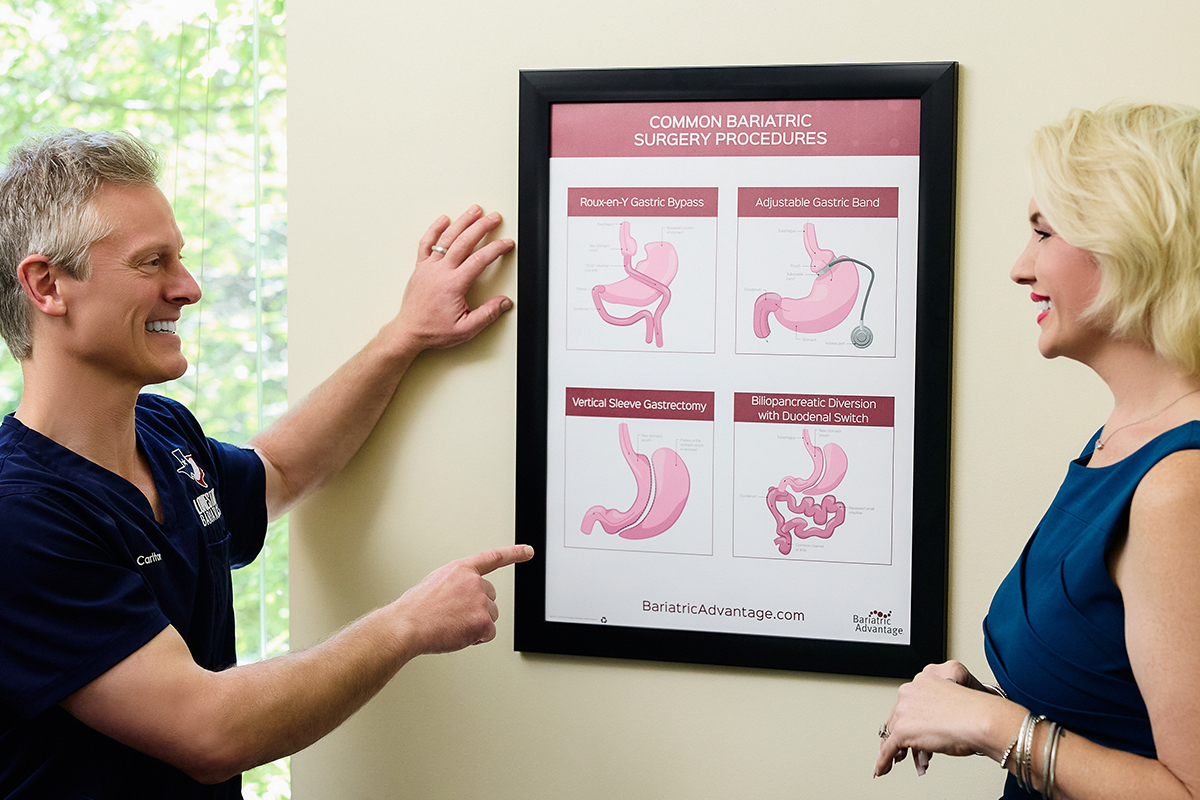One anastomosis gastric bypass (OAGB), performed by Dr. Chad Carlton at LoneStar Bariatrics, is a weight-loss surgery that reduces the size of the stomach and limits calorie absorption, helping you lose weight more effectively than traditional methods.
Bypass the Intestine With
One Surgical Connection
One anastomosis gastric bypass (OAGB) surgery in Plano, Collin County is a weight-loss surgery that helps you eat less and absorb fewer calories. Dr. Carlton creates a small pouch from your stomach and connects it to a part of your small intestine through an anastomosis (a surgical connection between two structures). Unlike the regular gastric bypass, OAGB involves only one surgical connection, making it simpler. This procedure makes you feel full faster and bypasses a section of the intestine, which reduces calorie absorption. The result is significant weight loss.

*Actual Successful & Satisfied LoneStar Patient
Benefits of One Anastomosis Gastric Bypass (OAGB):
- Simpler and quicker to perform than traditional gastric bypass
- Reduces the stomach size, making you feel full faster
- Bypasses part of the small intestine, leading to fewer calories absorbed
- Patients typically experience significant weight loss within 18 months
- Can improve obesity-related health conditions like diabetes and hypertension
- Minimally invasive surgery, performed laparoscopically with small incisions
- Studies show OAGB has comparable results to traditional gastric bypass
How Does One Anastomosis Gastric Bypass Work?
One anastomosis gastric bypass (OAGB) surgery promotes weight loss by changing the structure of your digestive system. Dr. Carlton creates a small stomach pouch from the upper part of your stomach, significantly reducing its capacity. This small pouch is then connected directly to a part of your small intestine through a surgical opening called an anastomosis. By bypassing a portion of the small intestine, the surgery reduces the length of the digestive tract, meaning fewer calories and nutrients are absorbed from the food you eat.
The procedure helps you lose weight in three key ways. First, the reduced stomach size makes you feel full after eating much smaller portions, which helps you consume fewer calories. Second, the bypassed section of the small intestine means that even the food you do eat is absorbed less efficiently, further reducing calorie intake. Finally, this surgery also affects your hunger hormones, making you feel less hungry. Together, these changes lead to significant and sustained weight loss and health improvements.
Am I a Candidate for OAGB?
You may be a candidate for one anastomosis gastric bypass (OAGB) if you have a body mass index (BMI) of 40 or higher or a BMI of 35-39.9 with a serious weight-related health condition such as diabetes or hypertension. If you have struggled to lose weight through diet and exercise alone, OAGB surgery in Plano, Collin County might be an option for you. It’s important to consult with Dr. Carlton to discuss your medical history, weight-loss goals, and whether OAGB is the right choice for your needs.

How Much Weight Can I lose With OAGB?
With one anastomosis gastric bypass (OAGB), you can expect to lose between 50% and 80% of your excess weight within 18 months. The most significant weight loss typically occurs in the first six months after surgery. Your exact results will depend on factors such as your starting weight, adherence to dietary guidelines, and commitment to a healthy lifestyle. Dr. Carlton and the LoneStar team in Plano serving all of Collins County, will support you throughout your weight-loss journey to help you achieve the best possible outcome and improve your overall health.
One Anastomosis Gastric Bypass (OAGB) FAQs
How long does the OAGB surgery take?
The OAGB surgery in Plano, Collin County concludes within 90 minutes. It is performed laparoscopically, which means Dr. Carlton makes small incisions in the abdomen to insert surgical instruments and a camera.
What is the recovery process like after OAGB?
Recovery from OAGB involves a gradual transition from a liquid diet to pureed foods and eventually to solid foods. Patients are encouraged to focus on lean protein, stay hydrated, and follow dietary guidelines provided by their bariatric team. Regular follow-up appointments are essential to monitor progress and address any complications.
What are the potential risks and complications of OAGB?
While OAGB is generally safe, potential complications can include bile reflux, anastomosis leaks, bleeding, blockages in the small intestine, and nutrient deficiencies. Long-term risks may include ulcers, narrowing of the anastomosis, and weight regain if dietary guidelines are not followed. Dr. Carlton takes all possible measures to minimize these risks.
Will I need to take supplements after OAGB?
Yes, because OAGB surgery in Plano reduces nutrient absorption, you will need to take vitamin and mineral supplements for life to ensure you get enough essential nutrients such as calcium, iron, and vitamin D. The LoneStar team will guide you on the appropriate supplements to take.

Why Choose Dr. Carlton in Collin County?
Dr. Chad Carlton at LoneStar Bariatrics is a board-certified bariatric and general surgeon with over 15 years of experience. He is not your typical surgeon — he is compassionate and remains intimately involved in every aspect of your care, from the initial consultation to the final stages of recovery and beyond. Schedule a consultation today to see how Dr. Carlton can help you achieve your weight-loss goals with one anastomosis gastric bypass (OAGB).
Contact LoneStar
Bariatrics Today
*Actual Successful & Satisfied LoneStar Patient